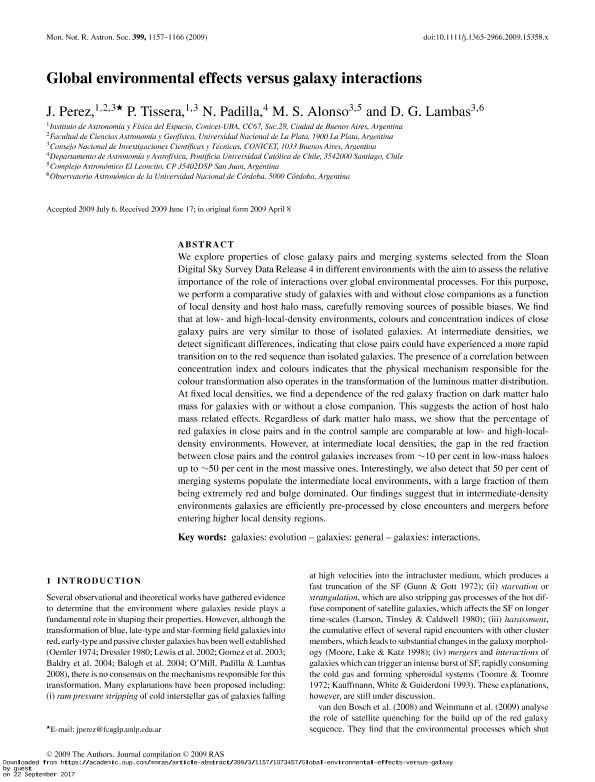Artículo
Global environmental effects versus galaxy interactions
Perez, Maria Josefa ; Tissera, Patricia Beatriz
; Tissera, Patricia Beatriz ; Padilla, Nelson David
; Padilla, Nelson David ; Alonso Giraldes, Maria Sol
; Alonso Giraldes, Maria Sol ; Garcia Lambas, Diego Rodolfo
; Garcia Lambas, Diego Rodolfo
 ; Tissera, Patricia Beatriz
; Tissera, Patricia Beatriz ; Padilla, Nelson David
; Padilla, Nelson David ; Alonso Giraldes, Maria Sol
; Alonso Giraldes, Maria Sol ; Garcia Lambas, Diego Rodolfo
; Garcia Lambas, Diego Rodolfo
Fecha de publicación:
10/2009
Editorial:
Oxford University Press
Revista:
Monthly Notices of the Royal Astronomical Society
ISSN:
0035-8711
Idioma:
Inglés
Tipo de recurso:
Artículo publicado
Clasificación temática:
Resumen
We explore properties of close galaxy pairs and merging systems selected from the Sloan Digital Sky Survey Data Release 4 in different environments with the aim to assess the relative importance of the role of interactions over global environmental processes. For this purpose, we perform a comparative study of galaxies with and without close companions as a function of local density and host halo mass, carefully removing sources of possible biases. We find that at low- and high-local-density environments, colours and concentration indices of close galaxy pairs are very similar to those of isolated galaxies. At intermediate densities, we detect significant differences, indicating that close pairs could have experienced a more rapid transition on to the red sequence than isolated galaxies. The presence of a correlation between concentration index and colours indicates that the physical mechanism responsible for the colour transformation also operates in the transformation of the luminous matter distribution. At fixed local densities, we find a dependence of the red galaxy fraction on dark matter halo mass for galaxies with or without a close companion. This suggests the action of host halo mass related effects. Regardless of dark matter halo mass, we show that the percentage of red galaxies in close pairs and in the control sample are comparable at low- and high-local-density environments. However, at intermediate local densities, the gap in the red fraction between close pairs and the control galaxies increases from ∼10 per cent in low-mass haloes up to ∼50 per cent in the most massive ones. Interestingly, we also detect that 50 per cent of merging systems populate the intermediate local environments, with a large fraction of them being extremely red and bulge dominated. Our findings suggest that in intermediate-density environments galaxies are efficiently pre-processed by close encounters and mergers before entering higher local density regions.
Palabras clave:
Galaxies
,
Evolution
,
Interactions
,
Environments
Archivos asociados
Licencia
Identificadores
Colecciones
Articulos(IAFE)
Articulos de INST.DE ASTRONOMIA Y FISICA DEL ESPACIO(I)
Articulos de INST.DE ASTRONOMIA Y FISICA DEL ESPACIO(I)
Articulos(IATE)
Articulos de INST.DE ASTRONOMIA TEORICA Y EXPERIMENTAL
Articulos de INST.DE ASTRONOMIA TEORICA Y EXPERIMENTAL
Articulos(ICATE)
Articulos de INST.D/CS ASTRONOMICAS D/LA TIERRA Y DEL ESPACIO
Articulos de INST.D/CS ASTRONOMICAS D/LA TIERRA Y DEL ESPACIO
Citación
Perez, Maria Josefa; Tissera, Patricia Beatriz; Padilla, Nelson David; Alonso Giraldes, Maria Sol; Garcia Lambas, Diego Rodolfo; Global environmental effects versus galaxy interactions; Oxford University Press; Monthly Notices of the Royal Astronomical Society; 399; 3; 10-2009; 1157-1166
Compartir
Altmétricas



